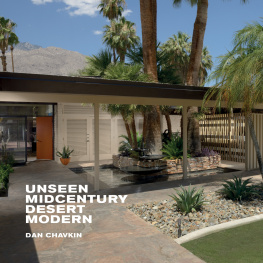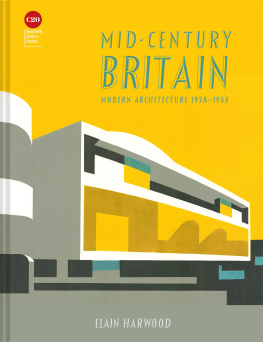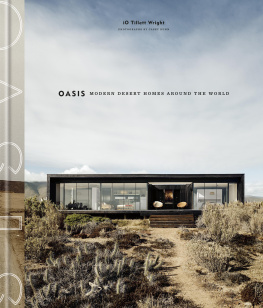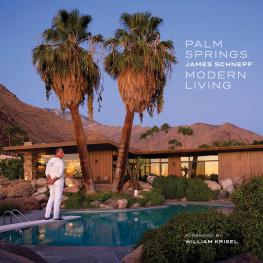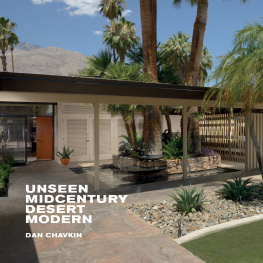Chavkin - Unseen Midcentury Desert Modern
Here you can read online Chavkin - Unseen Midcentury Desert Modern full text of the book (entire story) in english for free. Download pdf and epub, get meaning, cover and reviews about this ebook. City: Layton;UT, year: 2016, publisher: Gibbs Smith, genre: Detective and thriller. Description of the work, (preface) as well as reviews are available. Best literature library LitArk.com created for fans of good reading and offers a wide selection of genres:
Romance novel
Science fiction
Adventure
Detective
Science
History
Home and family
Prose
Art
Politics
Computer
Non-fiction
Religion
Business
Children
Humor
Choose a favorite category and find really read worthwhile books. Enjoy immersion in the world of imagination, feel the emotions of the characters or learn something new for yourself, make an fascinating discovery.
- Book:Unseen Midcentury Desert Modern
- Author:
- Publisher:Gibbs Smith
- Genre:
- Year:2016
- City:Layton;UT
- Rating:4 / 5
- Favourites:Add to favourites
- Your mark:
- 80
- 1
- 2
- 3
- 4
- 5
Unseen Midcentury Desert Modern: summary, description and annotation
We offer to read an annotation, description, summary or preface (depends on what the author of the book "Unseen Midcentury Desert Modern" wrote himself). If you haven't found the necessary information about the book — write in the comments, we will try to find it.
A rich photographic collection of largely unseen examples of desert modern architecture. Many of the buildings shown herein are not easily accessible by, or in some cases completely off-limits to, the general public.
Unseen Midcentury Desert Modern — read online for free the complete book (whole text) full work
Below is the text of the book, divided by pages. System saving the place of the last page read, allows you to conveniently read the book "Unseen Midcentury Desert Modern" online for free, without having to search again every time where you left off. Put a bookmark, and you can go to the page where you finished reading at any time.
Font size:
Interval:
Bookmark:

Unseen Midcentury Desert Modern
Digital Edition 1.0
Text and photographs 2016 Dan Chavkin
All rights reserved. No part of this book may be reproduced by any means whatsoever without written permission from the publisher, except brief portions quoted for purpose of review.
Gibbs Smith
P.O. Box 667
Layton, Utah 84041
Orders: 1.800.835.4993
www.gibbs-smith.com
ISBN: 978-1-4236-4206-0
Design Principal, Marmol Radziner
Over twenty years ago, in the summer of 1993, my partner Leo Marmol and I had the fortune of restoring Richard Neutras Kaufmann House in Palm Springs. For me, one of the most memorable moments came about a year into the restoration. We had removed all of the additions from the house, which had more than doubled in size over the nearly fifty years since it had been built. What remained, however, was the bare outline of the house as Neutra had conceived it: a skeleton of steel beams and columns, raw wood framing, and stone. It looked like the rugged and intuitive charcoal sketches Neutra drew of his houses as he designed them. I would walk slowly around the entire sitearound this skeletonand see a magnificent piece of sculpture from every angle. There was no front or back. From every angle the proportions were incredible. For me, this was the essence of desert modernist architecture.
On my frequent trips to the desert during the Kaufmann House restoration, I drove past many beautiful modern buildings but knew little or nothing about their origins. By the mid-1990s there was plenty of photography and writing on the work of the celebrated desert modernists, such as Albert Frey, John Lautner, and William Krisel. But there were many contemporary buildings that went undocumented. Today we have an incredible amount of access to information on the desert modernist masterpieces. But as Dan Chavkin imparts to us through his photographs, there is so much more in the expansive Coachella Valley that remains to be discovered: both the homes themselves and the architects who designed them. Who designed and built these modern buildings that still catch my eye on my drives through the desert? What is their story?
It is important to note that the early 1990s marked the beginning of a midcentury modern revival. The body of beautifully understated structures that bejeweled Palm Springs by the thousands in the 1940s and 1950s had fallen into disrepair and out of favor with the community. This drew preservationists to the region and began a new golden age of sorts for the Coachella Valley that continues to thrive today. Dan Chavkins book comes at an appropriate time. Amid copious documentation of the groundbreaking architects and their most influential works, Dan presents us with a compendium of the contemporary work of the unsung pioneers alongside homes by noted architects William Cody, Donald Wexler, and E. Stewart Williams. With Dans book, the community that now embraces its unique architectural past more than ever before has even more to celebrate. Decade after decade, fans of midcentury modern design have flocked to see these homes, to put a face to a name they have heard time and time again. Dans research of the unseen desert modernism in the low desert is an attempt at putting names to some old faces to whom we were never introduced.
I am both personally drawn to the desert and enjoy working in the desert. There is an unparalleled rawness and humbling vastness to the land and the sky above it. At first glance it might seem primitive and simple, but it is actually layered and complex. Chavkins thoughtful survey, which combines black-and-white and color photographs, represents this dual nature. The color photographs capture the desert light, and in many cases the glamour of a time past. In contrast, the black-and-white photographs remind us that all of those Julius Shulman photos etched in our minds were really an abstraction. The black-and-white photographs are stripped bare: abstractions that are not too far off from my best memory of the Kaufmann House in 1994the essence of desert modernism. Dans photos offer some insight into why we are drawn to the desert and its unique architecture.

The Coachella Valley, nestled between the San Jacinto, Santa Rosa, and Little San Bernardino mountains, lies one hundred miles east of Los Angeles. It is home to a significant number of structures designed by architects whose contributions to midcentury modern architecture are measured both by the countless admirers of this style and by those who have the great pleasure of living in these homes.
The vast majority of these midcentury modern masterpieces have gone largely unnoticed. Not because the architecture is substandard, but rather because that illustrious fraternity of architects have created a number of important and iconic examples of desert modern architecture, and its these paragons of modernist design that receive the majority of the accolades, attention, and visibility. As a result, many of the other homes and buildings designed by these architects remain unseen and therefore unappreciated.
Unseen Midcentury Desert Modern is a celebration of modernist architecture in the desert. For the first time, the viewer will be given an inside look at some of the numerous examples of this heretofore unseen architecture. This book showcases a diverse selection of residences, commercial buildings, and houses of worship, by both noted and lesser-known architects. Some of the residences showcased in this book are located in gated communities and cannot be seen by the general public. While many of the residences can be seen from the street, I feel these homes have not been further examined or appreciated.
I have come to realize there can be no definitive survey in one single book of the countless examples of midcentury modern architecture in the Coachella Valley. In my six years of living and working in Palm Springs, I have had the immense pleasure of photographing a great number of these homes. I am constantly finding or being introduced to more magnificent examples throughout the valley, in cities like Palm Desert, Rancho Mirage, Cathedral City, Indian Wells, and most of all, Palm Springs.
It wasnt until the summer of 2008 that I discovered desert modern architecture hiding in plain sight in Palm Springs, a city Id spent time visiting with my family on getaway trips. My love and appreciation for modern architecture was cemented when I began photographing homes and buildings in Palm Springs, guided by A Map of Modern Palm Springs offered by the Palm Springs Modern Committee. My love of midcentury modern architecture grew out of my passion for all things modernistfurniture, graphic design, ceramics, and decorative arts.
It is a great privilege to share with you my photographs of unseen midcentury desert modern architecture. Enjoy.

Without the extreme generosity and support from the home and business owners, this book would surely not be possible. Id like to thank publisher Gibbs Smith for believing in my work and having the excitement and tenacity to see it through to its completion. To Bob Cooper, my editor, for his guidance and ear. I am very fortunate to have Gary Wexler as the designer of this book. Our design aesthetic always seems to be in strict alignment. I owe a great deal of gratitude to Jeff Weyant, without whom I would not have nearly the same level of access and assistance. Since moving to Palm Springs, I have had an abundance of support, guidance, love, and appreciation for my work from the closely knit community of modernists Ive come to consider my family. Thank you! Most of all to my family: Mom, Scott, Noah, and LilyI love you with all of my heart.
Font size:
Interval:
Bookmark:
Similar books «Unseen Midcentury Desert Modern»
Look at similar books to Unseen Midcentury Desert Modern. We have selected literature similar in name and meaning in the hope of providing readers with more options to find new, interesting, not yet read works.
Discussion, reviews of the book Unseen Midcentury Desert Modern and just readers' own opinions. Leave your comments, write what you think about the work, its meaning or the main characters. Specify what exactly you liked and what you didn't like, and why you think so.

